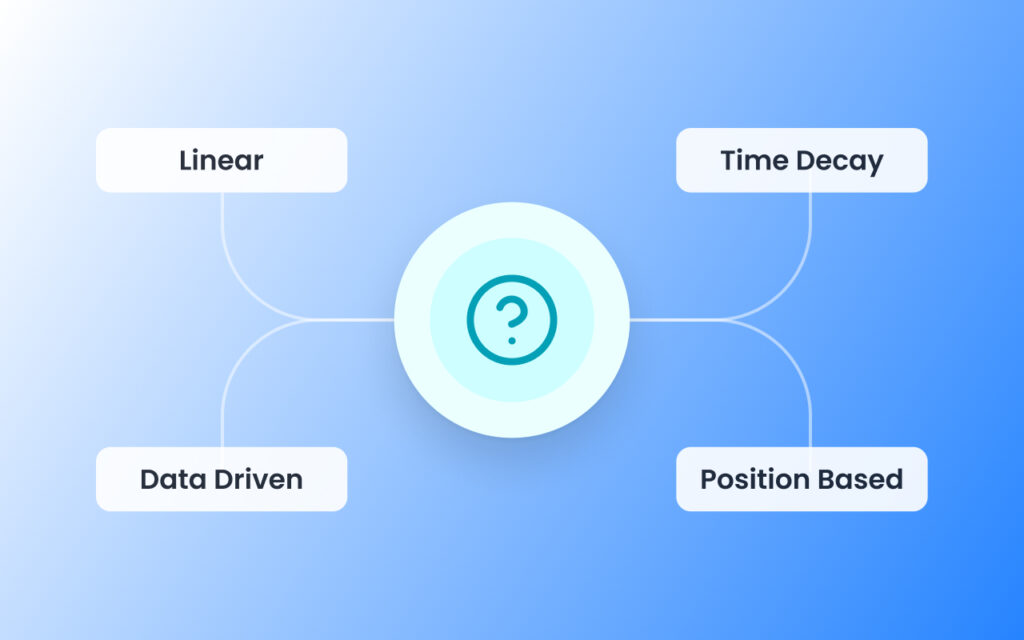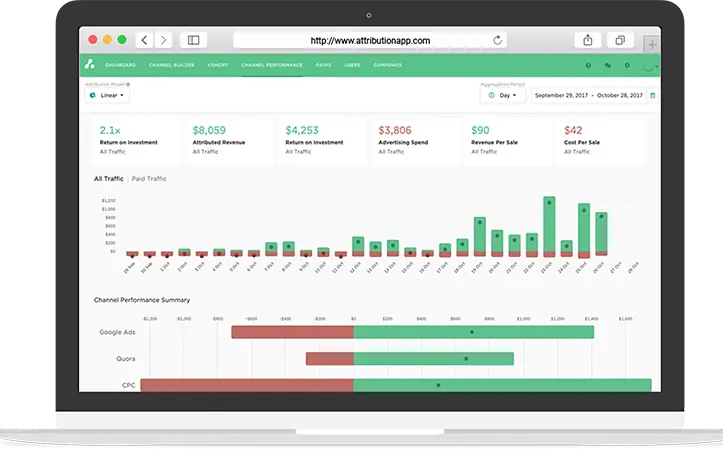Social media has become an essential part of the marketing mix, but accurately measuring its impact on business outcomes remains a challenge for many organizations. Likes, comments, and shares are easy to track, but connecting those engagement metrics to leads, conversions, and revenue is far more complex.
The unique characteristics of social media interactions–from private “dark social” sharing to multi-device customer journeys–make attribution particularly tricky. Throw in the limitations of native platform analytics and the challenges only compound. Marketers often struggle to get a clear picture of social’s role in driving business results, leading to a skewed perception of the impact of social channels and less than optimal strategy decisions.
In this guide, we’ll demystify social media attribution and provide a step-by-step framework for connecting your social efforts to real revenue outcomes. We’ll tackle common challenges, explore the differences between B2B and B2C approaches, and showcase how choosing appropriate tools will help to prove social media’s bottom-line impact and inform smarter decision-making.
Why businesses need to know exactly how social media is contributing to revenue
Accurate social media attribution strategies identify which social platforms, campaigns, and pieces of content are contributing to your bottom line. Some key areas where nailing your social media attribution strategy will create impact include:
- Preventing undervaluation of social’s contribution: Many social interactions, such as likes, comments, and shares, don’t directly lead to conversions, but they play a crucial role in the customer journey. They build brand awareness, trust, and engagement. By connecting these early-stage touchpoints to downstream revenue, you’ll be demonstrating social’s full impact and be more easily able to justify investment.
- Defending budgets with concrete data: Rather than relying solely on engagement metrics, you need to be able to defend your social media budget with concrete revenue data. When faced with budget cuts or competing priorities, having clear ROI data can be the difference between maintaining a robust social presence and having to scale back.
- Driving smarter strategy decisions: Insights gained from social media attribution drive smarter decisions about content strategy, platform selection, and audience targeting. By understanding which specific posts, ads, and campaigns are generating the most valuable leads and conversions, you can double down on what’s working and optimize underperforming assets.
Why attributing conversions to social media is a unique challenge
The unique nature of social interactions and platform limitations can make it difficult to accurately connect social touchpoints to downstream conversions. Let’s explore some of the key challenges marketers face when attempting to attribute revenue to social media.
Dark social sharing
One of the biggest attribution blind spots is a phenomenon known as “dark social.” Though it sounds pretty scary, dark social simply refers to old fashioned, person-to-person interactions: the private sharing of content that happens through channels like instant messaging, email, and text. When a user copies and pastes a link to share with their network instead of using a social share button, that referral data is easily lost. Dark social accounts for 69% of all shares globally, meaning a significant portion of social traffic is invisible to traditional analytics.

Platform limitations
Each social media platform has its own set of analytics with varying levels of granularity and attribution windows. This can lead to discrepancies between the data reported by the social network and what’s captured by your website analytics. For example, Facebook attributes a conversion to the last ad clicked within a 28-day window, while Google Analytics uses a default 30-day window for social referrals. Inconsistencies can make it difficult to compare performance across platforms and get a unified view of social’s impact.
Offline conversions
For businesses with longer sales cycles or offline conversion points, attributing revenue back to social touchpoints can be particularly tricky. A prospect may engage with multiple social posts before converting offline weeks or even months later. Without a way to connect that offline conversion back to the initial social interactions, the full impact of social media can be underreported.
These challenges may seem daunting but they’re not insurmountable. With the right tracking setup, attribution model, and tools, you can start to piece together a more complete picture of social media’s contribution to your bottom line.
Multi-device customer journeys
A GlobalWebIndex report found that the typical digital consumer now owns more than 3 connected devices. It’s highly likely that your customers frequently switch between devices as they move through the buying process. They may initially engage with a social post on their smartphone but wait until they’re on a desktop to complete a conversion. Cross-device behavior can create gaps in the attribution picture, making it challenging to connect the dots between social interactions and conversions.
How to implement social media attribution in 7 steps
Below we walk through a simple way that you can get your social media attribution started.
1. Set clear objectives
Establishing meaningful social media attribution goals is crucial to ensuring your efforts align with broader business objectives.
Don’t lean too heavily on vanity metrics, like comments, likes and shares. Instead, define KPIs based on conversion-related metrics that demonstrate social media’s true value. For example:
- Leads generated: The percentage of social media visitors who take an action that qualifies them as a lead.
- Click-through rate (CTR): The percentage of people who click a link or CTA in your social media post.
- Cost-per-click (CPC) and cost-per-acquisition (CPA): Metrics which compare ad spend with actual interactions.
- Conversion rate: The percentage of customers who take a desired action (e.g. making a purchase) after engaging with your content.
- Customer lifetime value (CLV): A prediction of the total value a customer will generate throughout their relationship with your business.
2. Configure proper tracking mechanisms
Configuring accurate tracking is the foundation of effective social media attribution:
- Ensure your technical setup is thorough, including UTM parameters for organic social posts and conversion pixels for paid social ads.
- Make sure to follow best practices during implementation to avoid data discrepancies, help to combat “dark sharing” data loss, and ensure accurate reporting.
- Take care to consider platform-specific nuances which may require tailored approaches. For example, Facebook’s Conversions API allows server-side tracking for more reliable data, while Twitter’s Conversion Tracking requires separate tags for web and app conversions.
3. Integrate social data with your CRM
Connecting social media touchpoints with lead and opportunity data in your CRM is essential for understanding social’s impact on revenue.
Popular CRMs like Salesforce and HubSpot offer native integrations with major social platforms, but may require additional setup to ensure all relevant data fields are synced properly. Regularly audit your social media-CRM integration to maintain data integrity and catch any sync issues or discrepancies early.
4. Select the right attribution model

Choosing the right attribution model depends on your business needs and customer journey characteristics.
- A B2B company with long sales cycles may prefer a position-based model that emphasizes both lead generation and deal acceleration.
- A B2C brand with shorter purchase cycles may opt for a time-decay model that prioritizes recent social touches.
Test multiple attribution models with your social media data to determine which provides the most accurate and actionable insights for your unique situation. Evaluate model performance based on criteria like predictive accuracy, alignment with other marketing channel data, and usability for optimization decisions.
5. Test both organic and paid social synergy
Tracking both organic and paid social touchpoints within a unified attribution system helps to understand the interplay between these two facets of your social media strategy. By capturing the full range of social interactions, you can identify patterns in how organic engagement assists paid conversions and vice versa.
For example, you might discover that users who comment on your organic posts are more likely to click through and convert on your paid ads. Or perhaps those who share your paid content organically end up being your most valuable leads. These insights will inform more impactful campaign planning.
6. Create a reporting framework
To effectively communicate the value of social media to key stakeholders, you’ll need to build reporting dashboards that clearly showcase social’s contribution to revenue.
- Focus on metrics that matter to your executive team, such as leads generated, pipeline influenced, and closed-won deals attributed to social touchpoints.
- Consider creating different views tailored to various audiences. A CMO dashboard might include high-level revenue impact data, while a social media manager dashboard would dive deeper into platform-specific performance metrics.
- Provide context around the numbers by including benchmark comparisons and highlighting key trends over time.
7. Continuously test and refine
Social media attribution is not a set-it-and-forget-it endeavor. As customer behaviors evolve and new platforms emerge, it’s crucial to continuously test and refine your attribution approach.
Use attribution insights to guide your social media experiments, identify opportunities for optimization and areas where your model may need adjusting. If you find that certain types of content or messaging are driving more valuable conversions, double down on those themes in your upcoming campaigns. A/B test different variations and measure their impact using your attribution framework, then iterate based on the results.
Advanced strategies for social media attribution
Once you’re confident that you have chosen the right attribution model and are analyzing and iterating effectively, you may want to consider introducing some more advanced tracking elements to your social media attribution strategy. These will help you to leverage multi-touch attribution and get a fuller picture of the customer lifecycle.
- Integrating offline touchpoints: Technologies like call tracking and geofencing can help bridge the attribution gap between online and offline interactions so that you can take into account offline touchpoints such as in-store visits or events.
- Weighted attribution for social touchpoints: Developing custom weighting systems that assign value to social touchpoints based on their specific role in your business model provides a more accurate picture of social ROI.
- Leveraging machine learning for dynamic attribution: Machine learning algorithms can uncover hidden patterns in your social attribution data and adapt to changing customer behaviors in real-time.
Unifying Social Media Data with Attribution’s Platform
The Attribution Platform provides a seamless solution for unifying social media data. The platform enables tracking and optimization for both paid and organic performance across major networks like Facebook, Instagram, LinkedIn, TikTok, and Twitter. Integrating directly with these platforms, Attribution captures ad spend, engagement, and conversion metrics in real-time, ensuring a holistic view of social performance.
A key advantage of Attribution’s platform is its automated cost data syncing, which eliminates the need for manual reporting. By pulling ad spend directly from social networks and aligning it with conversion data, you’ll gain accurate ROI calculations without tedious spreadsheet management. This automation enhances efficiency while providing a clear, data-backed view of profitability so you can provide seamless reporting for a variety of stakeholders without spending days on manual preparation.
Attribution also acts as a single source of truth, merging social media data with CRM insights, website interactions, and offline conversions. The industry’s broadest network of integrations allows businesses to connect social media engagement to real revenue outcomes, offering a comprehensive view of customer journeys across multiple touchpoints.

Leveraging machine learning, Attribution continuously adapts to shifting social media algorithms and evolving consumer behaviors. By identifying patterns in engagement and conversions, the platform helps marketers refine targeting, allocate budgets effectively, and maximize returns on social campaigns.
Implementing robust social media attribution is crucial for transforming social from a cost center into a revenue driver. With Attribution’s insights, businesses can confidently invest in high-performing channels, optimize ad spend, and prove social media’s impact on the bottom line.
Sign up and try Attribution today — pinpoint CAC by channel, audit funnels and conversion rates, scale revenue-driven content marketing, measure affiliate LTV and CAC (and more).
Social Media Attribution FAQs
What is social media attribution?
Social media attribution is the process of assigning credit to specific social media touchpoints (such as posts, ads, or campaigns) for their role in influencing a desired outcome, like a lead or sale.
What’s the difference between social media attribution and general marketing attribution?
While both social media attribution and general marketing attribution aim to connect marketing efforts to revenue, social media attribution focuses specifically on the unique challenges and opportunities presented by social platforms.
How does Attribution handle cross-device tracking for social media?
Attribution’s advanced tracking capabilities allow it to connect social media touchpoints across multiple devices, providing a more complete picture of the customer journey. By leveraging a combination of deterministic and probabilistic matching techniques, Attribution can identify when a user engages with a social media post on their mobile device and later converts on their desktop. This cross-device tracking ensures that social media efforts are properly credited for their role in driving conversions, even when the path to purchase spans multiple devices.
What is the difference between social media attribution for B2B and B2C businesses?
In the B2B world, social media plays a crucial role in building brand awareness, establishing thought leadership, and nurturing prospects through complex, multi-stakeholder sales cycles. It must also consider the different weights of social touchpoints based on the stakeholder’s role and level of influence.In contrast, B2C social media attribution often involves much shorter purchase cycles and more impulse-driven conversions. Attribution in this environment requires a greater focus on tracking immediate conversions from social posts and ads. Time-decay models that give more credit to recent touchpoints may be more appropriate than models which emphasize first touch and last touch.
